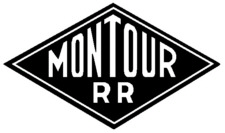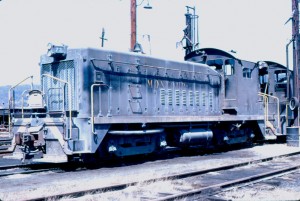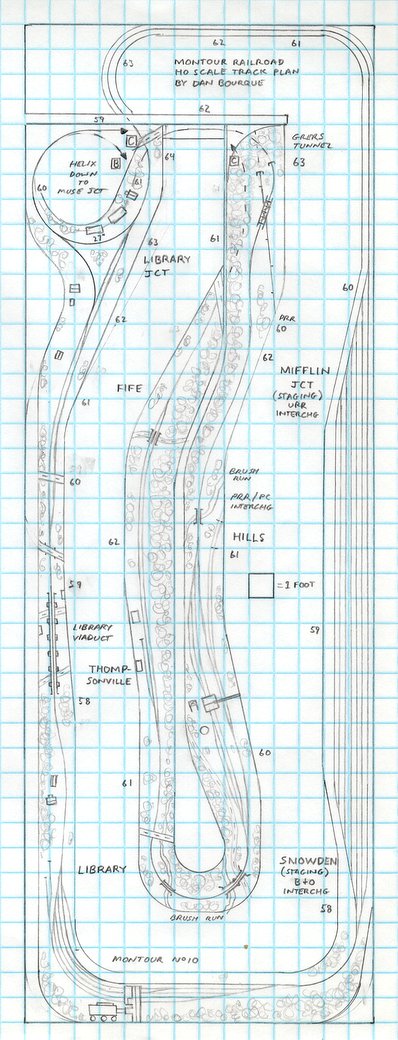- Size: 14′ x 40′
- Scale: HO
- Minimum Radius: 24″
- Minimum Aisle Width: 30″
- Designed by Dan Bourque
 The Montour Railroad existed to serve the coal mines along a semi-circle southwest of Pittsburgh, PA. By the 1970s, the railroad’s operations consisted mainly of four major raw coal loaders, the large Champion Prep Plant, and interchanges with several railroads. A few small non-coal industries broke up the monotony of endless coal hoppers, but black switchers and hoppers still ruled the line until its closing.
The Montour Railroad existed to serve the coal mines along a semi-circle southwest of Pittsburgh, PA. By the 1970s, the railroad’s operations consisted mainly of four major raw coal loaders, the large Champion Prep Plant, and interchanges with several railroads. A few small non-coal industries broke up the monotony of endless coal hoppers, but black switchers and hoppers still ruled the line until its closing.
The Layout
This track plan began as a challenge to design an HO-scale layout for a finished space above a large four-car detached garage. Because the space is long but narrow, the prototype needed tight radii to allow a peninsula up the middle of the room. That got me looking for prototypes that used switchers as mainline engines, and the Montour fit the bill nicely. This layout depicts the line as it appeared in the 1970s with four major loaders and the giant Champion Prep Plant. I wanted to include the essence of the operations for the entire line, so I chose to include all the major operational areas and scenes while compressing the areas between the scenes significantly. A double-deck design allowed me to include about 80% of the prototype including the yard and engine shops at Montour Jct, all the loaders, most of the non-coal industries, and 2/3 of the interchanges.

Montour RR SW9 No 73 waits at the MTR’s main yard at Montour Jct, PA for its next assignment in Apr 1973 -Dan Bourque collection
Most of the operations are on the lower deck which represents the west end of the railroad from Montour Jct to Muse Jct. The beginning of the line is the small yard, shops and P&LE interchange tracks at Montour Jct where the Montour’s fleet of switchers and crews was based. The MTR mainline travels under the helix, through a long hidden section and pops out at Lotus, home of Westinghouse, the first non-coal industry on the line. Next is the large prep plant at Champion which is modeled with most of its tracks. It’s the centerpiece of the layout because it was the centerpiece of Montour operations in the diesel era. From Champion, the layout models the interchanges with the PRR/PC at McDonald and the P&LE/NW interchange at Southview. I chose to come up the far side of the peninsula instead of the near side so I could include the branch to Westland which included two loaders. This means crews will have a long way to walk to follow their train, but it improves the prototypical operations significantly. The final scene is Muse Jct. where the short Muse Spur branches off to serve the Chemicals & Solvents Co with tank cars. The industry isn’t modeled, but the modeled portion of the spur still serves as the industry operationally–I moved a short siding from the other end of National Tunnel to the modeled end to enable operations on the spur.
The upper deck begins right above Muse Jct (no walking around the peninsula this time) with the neat scene at Grers where the MTR and PRR exit tunnels and the MTR immediately crosses the PRR on a truss bridge. The next scene is Hills, site of the Montour No. 4 loader and a lesser used interchange with the PRR. The final scene is the Library Branch including the wye at Library Jct., the Library Viaduct, and the large Montour No. 10 tipple. The grade from Montour 10 to the Jct. is a prototypical 2+% against loads. The viaduct is built above a dead space on the lower level so it doesn’t impinge on the lower deck. The final piece of track is a double-ended staging yard which represents the interchanges with the Union RR at Mifflin Jct (end of the MTR main reached by trackage rights) and the B&O interchange at Snowden at the end of the Library Branch. This staging yard also makes a continuous running loop of the upper deck which is handy if you just want to watch trains run. I chose not to model Mifflin Jct because the ceiling in this room is angled starting just above the level of the upper deck–good for staging but not so good for scenery.
This is a large layout with many trains, so a high-end DCC system with a couple of boosters are recommended to run the trains. Radio throttles would also simplify operations, especially given the nature of the long walk around the peninsula for mainline trains. Construction would be pretty straightforward, and the only significant hidden trackage is the helix and the bit of mainline between Montour Jct. and Lotus. The layout can be operated without duck-unders (the stairs bring operators into the middle of the layout aisle without ducking), but I have included a duck-under at the narrowest point of the peninsula for spry crew members who want to follow their train between Champion and McDonald without circumnavigating the peninsula.
Lower Deck
Upper Deck
Operations on this layout would keep several crew members busy for many hours. Crews would consist of a yard crew/hostler to work Montour Jct, one or two yard crews to work Champion, and 3-4 road crews to work mine runs and interchange trains. A dispatcher would be needed to keep everything running without incident. At the beginning of the session, the majority of the switchers and cabooses would be tied up at Montour Jct with one or two sets at Champion. The interchanges would be full of empty hoppers and a handful of non-coal cars. Mines would have loaded hoppers, and Champion would be filled with a mix of empty local-service hoppers and loaded clean-coal hoppers.
The basic flow of the Montour was 1) mine runs pick up hoppers in local service at Champion, 2) mine runs deliver empties to the loaders, 3) mine runs bring raw coal (“green coal” in Montour parlance) from the mines to the prep plant at Champion, 4) interchange trains pick up empty hoppers from the major interchanges, 5) interchange trains drop empty hoppers at Champion, and 6) interchange trains deliver trains of “clean coal” loaded at Champion or Disco (adjacent to Champion) to the major interchanges. Because of the small locomotives, sharp curves and steep grades on portions of the railroad, the Montour tended to run many shorter trains rather than long ones with the notable exception of a unit train that was loaded at Champion and delivered to the PC/Conrail at McDonald in later years.
If you plan to recreate any portion of the Montour, I highly recommend finding a copy of Gene Schaeffer’s excellent book Montour RR published in 1997.
Things I Like About this Plan:
- Captures the majority of operations for an entire busy railroad
- No duck-unders
- Important scenes can be modeled fairly accurately
- All staging is visible
Things I Don’t Like About this Plan:
- Tight curves
- Very compressed between scenes
- Few “passing sidings” in the aisles for operators
- Need to walk around peninsula to get back to train
Related Products:






Hi Dan, Your Montour plan is awesome. Butt-head switchers and coal loaders in a busy heavy industry setting would be something to see. I hope someone is inspired to build some or all of this pike. Thanks P.S. Genes book is excellent reading.